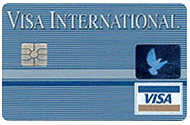
A smart card looks just like a credit card, only with a chip embedded in its plastic. Imagine replacing the hologram on a standard credit card with a similarly thin chip and you get the idea. Most smart card chips are about the size of a dime (only thinner) and can be recognized by their distinctive gold terminals. Figure 8.1 shows a Visa smart card.
A smart card chip is actually a complete little computer with nonvolatile memory, storage, a card operating system (COS), and accompanying communication protocols. The most advanced smart cards on the market have the processing power once found in an IBM-XT (with less memory, of course). There are many different uses for smart cards. Smart cards can serve as:
CADs are also present at merchant sites (usually in the form of point-of-sale devices) and at issuing banks. These CADs may look much like a typical point-of-sale credit card processor, with a small display screen and a few buttons for answering queries or entering PINs. In similar fashion to today's ATMs, a smart card is inserted directly into the reader. The reader then provides power to the card and sets it up to receive software commands. Although a CAD of this sort may look like an ATM on the outside, a smart card is much more powerful than an ATM card or a mag-stripe credit card. These latter cards store only a few kilobytes of information on the magnetic stripe and are not capable of performing computations. Smart cards can store many megabytes of information and carry out sophisticated cryptographic calculations. Another sort of CAD more commonly encountered by developers is a CAD connected directly to the serial port of a standard PC. Using development environments similar to those used in normal application development, programmers can create code for smart cards, download it into a prototyping card, and in this way create new smart card applications. Most major smart card vendors have proprietary Java development environments: Gemplus offers the GemXpresso environment; Schlumberger offers Cyberflex. There are many custom command sets for smart cards. In fact, there are so many custom environments and they are so specialized that the number of smart card programmers is very small. Considering that smart cards are traditionally programmed in platform-specific assembly languages and that each vendor has a different language, the small number of programmers should come as little surprise. The situation could be worse, of course. At least all of the major vendors conform to a set of common communications standards. The ISO 7816 specifications provide at least some common ground and ensure that smart cards have similar terminal pin-outs, accept standard protocol messages, and store some information in databases of common design [ISO7816, 1987]. ISO 7816 defines some commands in great detail and lays out communication protocols used by smart cards. Because of the existence of 7816, a smart card made by, say, Gemplus, can interface with a CAD meant for, say, Schlumberger cards. Smart cards have long been associated with security since they provide a partial solution to the need for personal identification and nonrepudiation. Because smart cards provide more nonvolatile storage than other highly portable devices, they make ideal storage compartments for digital identities. They can also compute hashes, session keys, digital signatures, and MACs right on the card. To the extent that a card is tamper resistant (something we will discuss further later in this chapter), it can be used to store important secrets such as DES keys or RSA private keys.

Chapter... Preface -- 1 -- 2 -- 3 -- 4 -- 5 -- 6 -- 7 -- 8 -- 9 -- A -- B -- C -- Refs
Copyright ©1999 Gary McGraw and Edward Felten. |


